Cartrix Honda NSX “Raybrig”
A look at fraternal twins
My
first Cartrix car was the Honda NSX “Mobil 1”, at the time, the only company
producing the NSX. The Honda NSX is better known on the Japanese GXT circuit
but it looks good and has a remarkably short history from engineering
development to race results. Cartrix had produced a previous edition, the
Takata Test car (0402) that piques my interest but
I avoid black cars as they do not show up well on a black track, even with
green wheels. The next NSX was the excellent rendition done by
Ninco with their Autobacs and Epson versions.
Without even a short break to replenish my slot car allowance I see two new
NSXs from Cartrix in a beautiful shade of blue and
they looked like identical twins. Searching the Internet for information on
the difference between the two models was fruitless; e-mail to the
manufacturer and distributor went unanswered (probably a translation
problem). I have to thank Becky at Slot Car World for bringing the models
into stock, posting some of the specifications and shipping me one of each.
Enough with the history, let’s take a closer look at the models. Right out of the box the livery on these two is strikingly attractive; silver lower body over sprayed with a medium blue upper body and precise, clear tampo markings from the distinctive Raybrig on the doors and wing to tiny ones that challenge the ability of my bifocals but are crystal clear under a magnifying glass. A clear coat is present and sprayed without flaw but it must be just a single coat. I did note one small area of over spray on a rear bumper, there was silver where it should have been blue, very minor and only on one model, one could almost think they were airbrushed by hand.
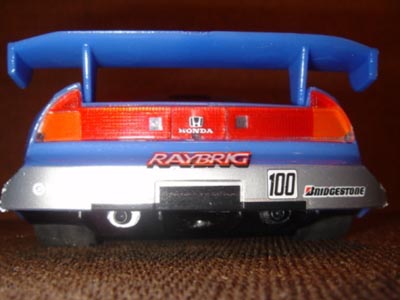
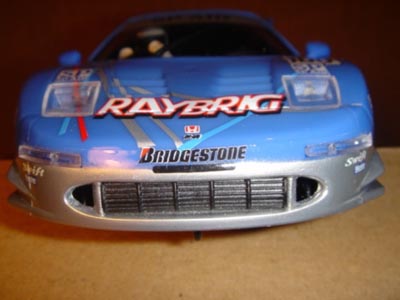
There are excellent examples of model car type detail in the front grill, headlights, see-through hood louvers, windshield wiper, and reflective surfaces on the mirrors. The side windows have molded air vents while there are actual intake openings in the rear deck window and behind the doors. A couple of areas that could have a little more detail was the fueling point on the right side, it’s just a depression in the plastic body painted over in blue and the lack of air exhaust vents at the rear of the front quarter panels. I do not know if I would have noticed or have been as picky if I had not seen these features on another model.
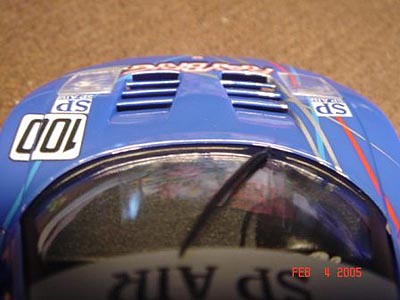

The tires and wheels are the most visible indication that these are not identical twins. The 0408 version has very nice six spoke forged wheels with visible, detailed brake rotors. The 0409 version has a spider spoke wheel with visible but less detailed brake rotors. The addition of brake rotors is an improvement over their previous model.


An interesting annoyance on all three models is the right rear tire rubs on the wheel well. The left side is fine, not too much clearance, not to little. You will also be happy to know that the rear wing is well matched, Tampo stamped nicely, and re-installs quite easily after the crash.
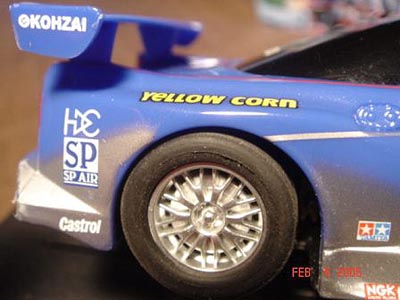
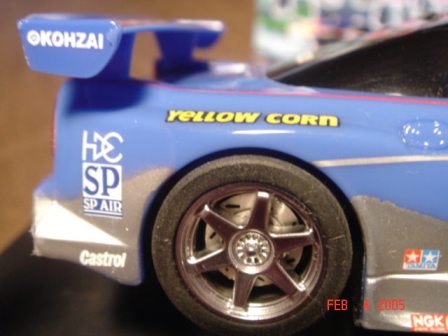
Authenticity dictates a right side driver and that is what you’ll find in this Cartrix version of the NSX. However, you will not find much of a driver. He is there from the rib cage up and grips the steering wheel with mittens while facing a dash with visible gage faces. This feature will please the racers since it leaves a lot of room inside for tuning or installation of LEDs for lights.
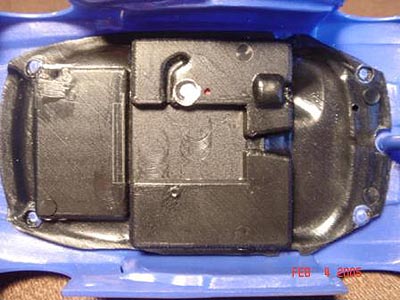
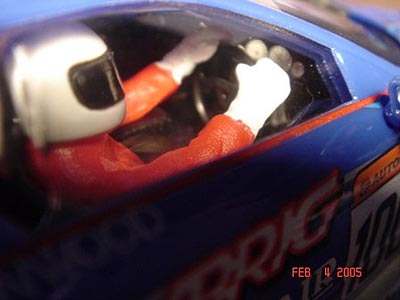
As soon as you turn the model over you will notice the real difference between these models. The 0408 model is done in an inline configuration while the 0409 is a sidewinder. Removing the body from the chassis was too simple with one screw under the rear portion of the guide and the other between the molded dual exhaust on the rear. The only problem with this two screw mount is that it can allow the chassis to flex or arrive in a bicycle configuration rather than a tripod. I did not note any problem with either model and the chassis appear very stiff due to the ribbing on the inside.
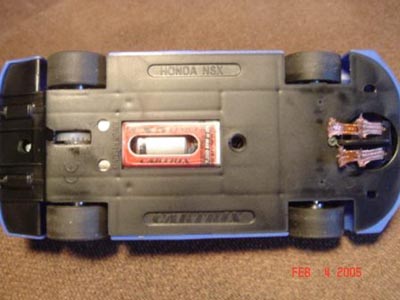

But the difference does not end there. The inline version has the Cartrix TX5 Genius motor rated at 22,500 rpm at 12 volts turning an 8 tooth pinion that drives a 27 tooth crown gear producing a gear ratio of 3.38. The 0409 has a Cartrix TZ Race 26,000 rpm (at 12 volts) motor in sidewinder fashion with an 11 tooth spur gear turning a 36 tooth crown producing a gear ratio of 3.27.
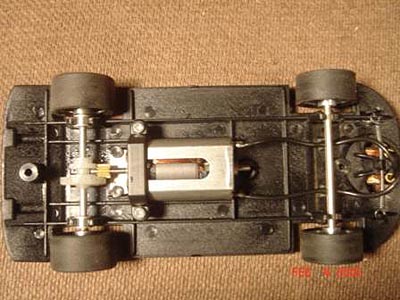
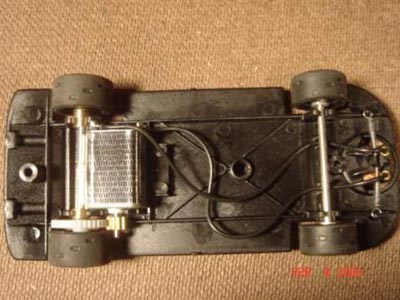
Drive components are well mounted to the chassis with the inline strapped in and screwed down while the sidewinder is secured on both ends of the can. If the 0409 sidewinder with its TZ Race motor is the ‘racing’ version of this model that might explain the difference in axle bushings. The 0408 has aluminum, while the ‘race’ version has brass bushings. This distinction carries through to the tires as well where the 0408 has a soft, grippy rubber tire while the 0409 has a harder rubber with a ‘rain tread’ surface. The tires are not interchangeable due to a difference in wheel size; the 0409 has smaller wheels.
The magnet pocket has the same construction on both models with two small round tabs holding the magnet down and a slight rim to hold it into the pocket. On the 0408, the pocket is behind the motor under the pinion and just in front of the rear axle. The 0409 has it’s magnet in front of the motor and about an inch and a half forward of the rear axle, also the magnet is colored black. I test the magnetic attraction by measuring the amount of weight it can support while the car rests on a plastic track that has been stripped of conductive rails. The 0408 supported 56 grams while the 0409 supports 46 grams both cars weigh 86 grams.

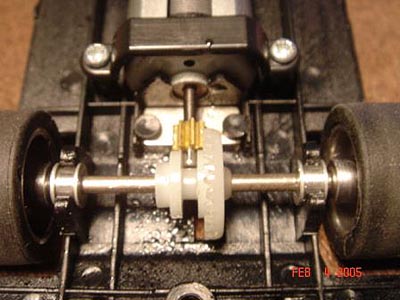
One more feature to look at before we get to the behavior of these two on the track is the guide. Cartrix installed their unique and very effective self-centering guide with the spring stretched through the guide pin. I usually have problems with these double braid guides and end up trimming the front braid or removing the rear section. I have not altered my first Cartrix NSX and probably will not do more than adjust these. There is a small amount of overlap between the two sections and after a small adjustment on one of them, it lies relatively flat.


My first measure of a cars performance is the straight from the box test, adjust the braid, stick it on the track, and squeeze the controller. Both cars worked and would not require any further ‘tuning’ to bring joy to the rank amateur, beginner, or child. If one was interested in doing a little tuning, the rear tires could use a light sanding to ensure the entire surface was in contact with the track. As previously mentioned, the right rear wheel well needs a clearance adjustment and not very much. There is quite a bit of play in the front tires both side to side and up and down. The rears had not one smidgen of play, they are just fine.
To give you some racing numbers, I use a ‘test track’ that I constructed shortly after getting back into the hobby. I changed my racing circuit so often I had nothing to compare the cars against. Test track is an oval with an R3 curve, R2 curve, decreasing radius turn, and an R1 curve. There are five straights per side with a lane 2 track length of 17.73’. The fastest recorded time of 1.15 seconds is shared by a Indy Grip clad Scalextric Indy car and a Carrera Ferrari Formula 1 with the spacer installed on the rear magnet. With these two cars you can almost just hold the trigger through the entire lap. By the way, the slowest car I have is a Pink Kar VW at 3.167 but what do you expect with an HO motor and no magnet.
I baseline a car after initial tuning by running ten, ten lap heats, drop the fastest and slowest times and average the other eight. The Cartrix 0408 Honda NSX “Raybrig” with the TX5 mounted inline achieved an average time of 1.55875 seconds while the 0409 with the TZ Race mounted sidewinder style achieved a 1.897 seconds. Now isn’t that exactly what you did not expect? The ‘regular’ version beat by the ‘race’ version? My original Cartrix Honda NSX Mobile 1 has the same configuration and weight as the 0408, the magnet had one gram greater attraction and it runs 1.50 seconds on test track after quite a bit of ‘break in’ time. On the track, you can feel the additional power and speed of the 0409 ‘race’ version, the problem is keeping it on the track. The harder tires with less grip, the forward position of the magnet with ten grams less attraction, work against the more powerful motor. With a little tuning and maybe a change in tires this car could reach its potential.
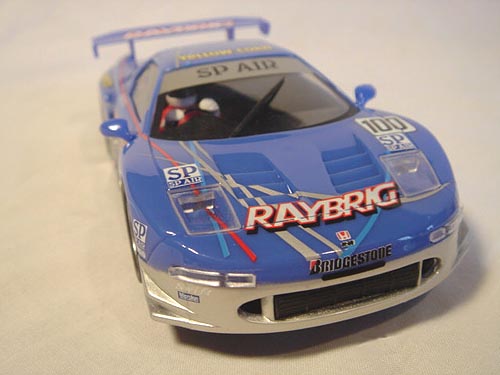 Just
for comparison, the Ninco Honda
NSXs achieves a 1.6132, weighs 83 grams and has
magnet attraction of 45 grams. A couple of final thoughts, these models are
good looking and fun to race and there is a lot of potential for tuning them
to higher levels of performance if that is your desire. However, you can also
just have fun right out of the box and never do anything.
Just
for comparison, the Ninco Honda
NSXs achieves a 1.6132, weighs 83 grams and has
magnet attraction of 45 grams. A couple of final thoughts, these models are
good looking and fun to race and there is a lot of potential for tuning them
to higher levels of performance if that is your desire. However, you can also
just have fun right out of the box and never do anything.
I feel Cartrix and its U.S. distributor (REH) could do a much better job of providing information to its retailers and the enthusiast. Knowing they are producing both an inline and sidewinder could mean more sales. After learning about the two version of the Raybrig, I went back and found that there were two versions of the Mobil 1. The 0404 inline version I have and the 0405 version I did not know about and can only find with overseas Internet e-tailers.
This was an interesting, enjoyable exercise and I hope you enjoy the fruits of my labors. The views express here are my own and I purchased both models so there is no outside influence. And remember, we are never too old to enjoy our childhood.
Update: In honor of the launch of the NASCAR season I set up a 4x16 foot four-lane oval with 12’ straights. After the initial race weekend, I decided to try the Cartrix twins on something less curvy than my test track or road course. I ran both cars in 10 ten lap heats again and the results were interesting enough to do this update. The 0408 inline achieved an average of 3.033 seconds per lap while the 0409 sidewinder had an average of 3.133 seconds per lap. Again, the ‘racing’ model was beat by the ‘regular’ model but not by very much. I tried my best to get the ‘racing’ version to beat the ‘regular’ one and could in one heat or another but as the final results reveal, the 0408 ‘regular’ model is slightly faster. The 0408’s 10 gram advantage in magnetic attraction is enough to overcome the 3,500 deficit in motor rpm. The good news for me was these two models are not as different on the track as I originally thought so racing them together will be possible…and fun.
"Ditch Dave"
